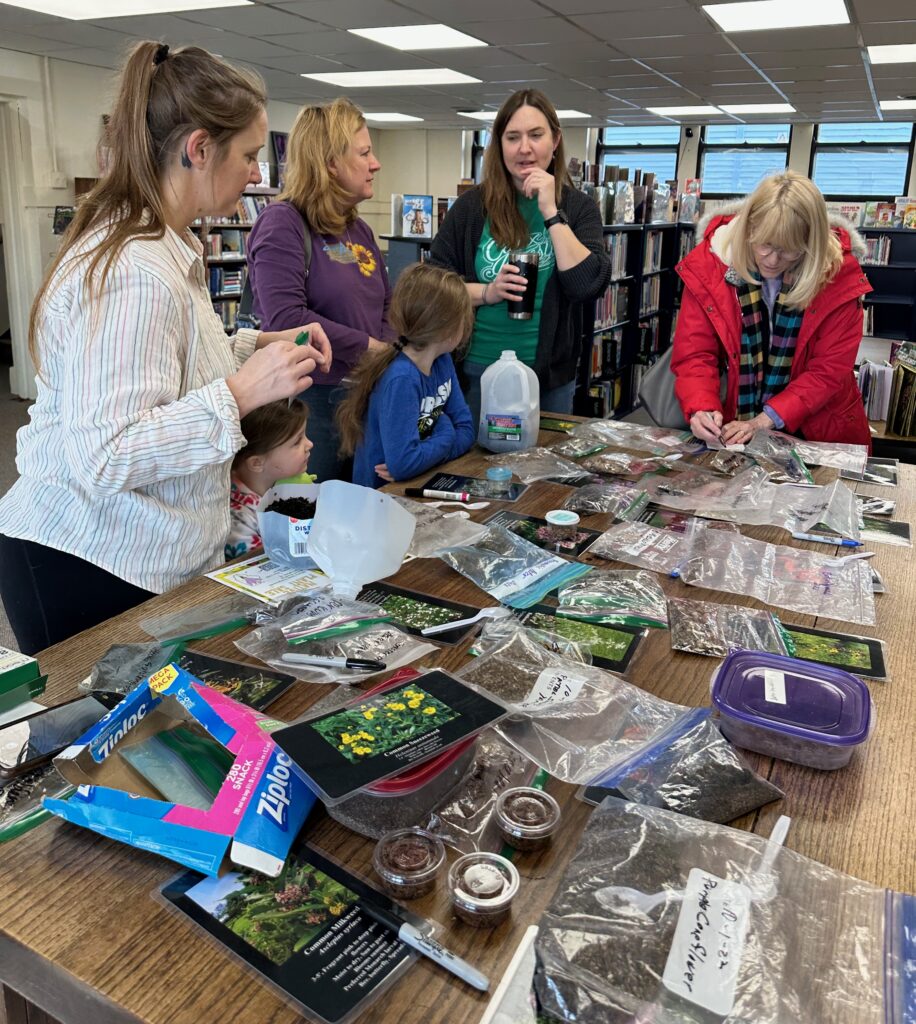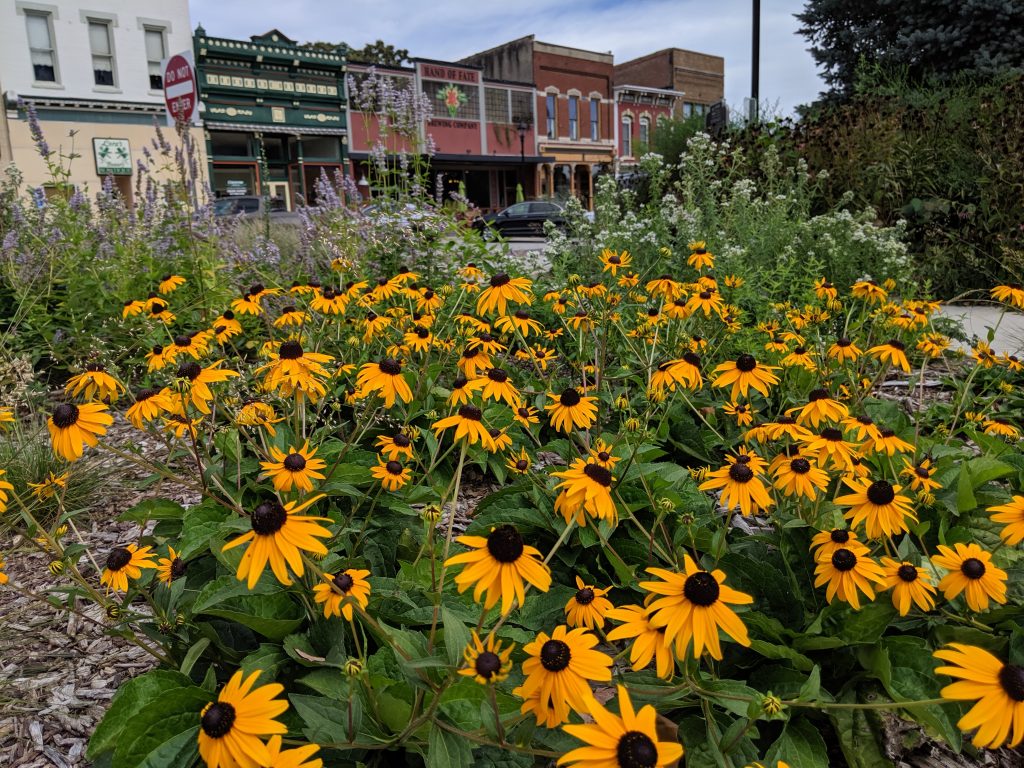Trails & Greenway is a proud sponsor of this family event organized by Birth to Five Illinois: Region 51 to introduce little ones to gardening with hands on experience of planting vegetable and native pollinator plant seeds. They will also learn about the importance of pollinators for our food supply. See the image below for event details and list of sponsors. If you’re interested in helping out let us know.
Sip n’ Sow Seed Sowing Workshop
Sip n’ Sow Seed Sowing Workshop
1st & 3rd Boutique & Wine Bar
January 12th from 6:00 to 8:00
1st & 3rd Boutique & Wine Bar has generously donated their event space. Please show your support — come early to shop, get a beverage & maybe a charcuterie board!
Event Limited to 30 Registered Participants — Fill Out Form at Bottom of Page
It’s never too soon to think of spring! Join some adult-only fun at the Sip n’ Sow Workshop! Sip a glass of wine and sow some native flower seeds for your summer garden. Native plants attract pollinators and serve as butterfly host plants, including many species growing on the square in Petersburg.
The evening will kick off with a slide presentation with photos and discussion of some of the species that will be available. Participants will then use the winter sowing technique to plant native species of their choosing. Seeds, soil, tools, and some containers provided. Participants are encouraged to bring additional CLEAN plastic milk jugs if you wish to plant multiple containers.
Alana McKean (Starhill Forest Arboretum), Cindy Andreasen (Illinois Extension Master Gardener), and Terri Treacy (Menard County Trails & Greenways) will be leading the workshop. Bring your questions about gardening with native plants and any native seeds you wish to share!
No fee but donations appreciated! And, please support 1st & 3rd — come early, shop, grab a beverage and even a bite to eat!
Questions? Email Cindy at event@menardcountytrailsandgreenways.org; (Please don’t contact 1st & 3rd — use the email provided!)
For planning purposes registration is required.
Plant pollinator habitat at home
Wanting to add more pollinator habitat at home? Look no further: native plant seed packets are available again in Petersburg! You can find displays at the Petersburg Public Library, 1st and 3rd Boutique, the Talisman, and the Crazy Daisy Gift Shop. This year we are offering 13 colorful species collected from the plantings on Petersburg’s square, Historic Wayside Park and our members’ own gardens and prairies. The packets are free, but we welcome donations that support Menard County Trails & Greenways. The displays will be restocked until we run out!
Wondering how to choose?
Check out blog posts highlighting the available species:
Lanceleaf Coreopsis, Purple Prairie Clover, Golden Alexanders
Small Yellow Wild Indigo, Butterfly Milkweed, Blue Star
Black-eyed Susan, Rattlesnake Master, Purple Coneflower
Swamp Milkweed, Sneezeweed, Aromatic aster
We’ve added one new species to the mix this year: Wild quinine. More on that species soon!
Wondering how to plant them?
Follow the detailed planting instructions on the back of each packet, and check out this blog post with instructions on the winter sowing method. Also– watch for an announcement about upcoming winter sowing workshops where we’ll have these species and many more to share!
Winter Seed Sowing Check In
Time to check in with our winter sowers! In the past few weeks, we’ve seen a lot of seedling germination. There is some variation, so it may have taken some containers a long time to show anything, but by now they should all have germinated and growing!

Removing the Tops and Watering
The weather has been pretty erratic this month, with some very warm days and some very cold nights. Up to this point, the top of the milk jug or container lid has helped to retain moisture and protect seedlings from temperature extremes and wind. Now that the temperatures have turned quite warm some days, it is important to open the containers up. This allows for good air circulation that will toughen up the plants and prevent fungal diseases. On particularly warm days, leaving the lid on can be very detrimental. Those delicate seedlings can bake in the heat! Continue reading “Winter Seed Sowing Check In”
Winter Seed Sowing
Winter seed sowing is a great way to grow most native plants! The seeds of many native species require cold, moist stratification to germinate. This occurs naturally when a seed falls on the soil and goes through an average Illinois winter.

These conditions can be mimicked in the refrigerator with a moist paper towel or a spoonful of sand, planting the seeds after meeting the required time for stratification of a particular species.
Winter sowing is an even simpler option—great for gardeners of all levels of experience. Planting in a milk jug or other recycled container gives seedlings a head start, as the containers create a mini-greenhouse to trap heat, speeding up germination and protecting seedlings during spring cold snaps, and lets nature work its magic! Continue reading “Winter Seed Sowing”
Pollinator Plants for Your Garden — Part 4

This post wraps up our 4 part blog series describing 12 easy-to-grow plants for attracting pollinators (butterflies, bees, etc) to your garden. View earlier blog posts here.
The final three plants described in the post are swamp milkweed, sneezeweed and aromatic aster. All 12 species discussed in the series are available for free (while supplies last!) a locations around Petersburg–see December 12th blog for details. Continue reading “Pollinator Plants for Your Garden — Part 4”
Pollinator Plants for Your Garden — Part 3

This is Part 3 of a 4 part blog series describing 12 easy-to-grow plants for attracting pollinators (butterflies, bees, etc) to your garden. If you missed Parts 1 and 2, you can read Part 1 here; read Part 2 here. The 12 species discussed in the series are all available for free (while supplies last!) a locations around Petersburg–see December 12th blog, Create Your Own Pollinator Habitat at Home, for details. Continue reading “Pollinator Plants for Your Garden — Part 3”
Pollinator Plants for Your Garden – Part 2

This is Part 2 of a 4 part blog series describing 12 easy-to-grow plants for attracting pollinators (butterflies, bees, etc) to your garden. If you missed Part 1 last week, you can read it here. The 12 species discussed in the series are all available for free (while supplies last!)–see December 12th blog, Create Your Own Pollinator Habitat at Home, for details. Continue reading “Pollinator Plants for Your Garden – Part 2”
Pollinator Plants for your Garden – Part 1

This is the first of a 4 part blog series describing 12 easy-to-grow plants for attracting pollinators (butterflies, bees, etc) to your garden. In addition, most of the species provide birds with seed in the winter–so don’t cut back plants until late spring!! The 12 species are all available for free (while supplies last!)–see December 12th blog, Create Your Own Pollinator Habitat at Home, for details.
Each Thursday through January 5th we’ll feature 3 of the 12 plants with detailed descriptions of the plants as well as specific sowing instructions. Note however, for those that say to direct sow in spring, you may actually direct sow them in late fall/winter. In nature the seeds would go through winter and just come up when they’re ready. If you’re late fall/winter sowing a bunch of plants, it’s kind of convenient to just do them all the same way! Continue reading “Pollinator Plants for your Garden – Part 1”
Create Your Own Pollinator Habitat at Home
 Wanting to add more pollinator habitat at home? Look no further: native plant seed packets will be available in Petersburg this week! You can find displays at the Petersburg Public Library, 1st and 3rd Boutique, the Talisman, and the Crazy Daisy Gift Shop. This year we are offering a dozen colorful species collected primarily from the plantings on Petersburg’s square. The packets are free, but we welcome donations that support Menard County Trails & Greenways. The displays will be restocked until we run out!
Wanting to add more pollinator habitat at home? Look no further: native plant seed packets will be available in Petersburg this week! You can find displays at the Petersburg Public Library, 1st and 3rd Boutique, the Talisman, and the Crazy Daisy Gift Shop. This year we are offering a dozen colorful species collected primarily from the plantings on Petersburg’s square. The packets are free, but we welcome donations that support Menard County Trails & Greenways. The displays will be restocked until we run out!
Wondering how to choose? Follow along as we highlight these 12 species in upcoming posts!
Wondering how to plant them? Follow the detailed planting instructions on the back of each packet. Plus, a future blog post will focus on sowing native seeds. Feel free to ask questions here or join us at the winter sowing workshop–registration required–only 4 spots left!
 Here are the species available this year:
Here are the species available this year:
- Amsonia tabernaemontana, Blue star
- Asclepias incarnata, Swamp Milkweed
- Asclepias tuberosa, Butterfly weed
- Baptisia tinctoria, Small yellow wild indigo
- Coreopsis lanceolata, Lanceleaf Coreopsis
- Dalea purpurea, Purple Prairie Clover
- Echinacea purpurea, Purple Coneflower
- Eryngium yuccifolium, Rattlesnake Master
- Helenium autumnale, Sneezeweed
- Rudbeckia fulgida, Gold coneflower
- Symphyotrichum oblongifolium, Aromatic Aster
- Zizia aurea, Golden Alexanders
This is made possible in partnership with Starhill Forest Arboretum and Rudin Printing.



